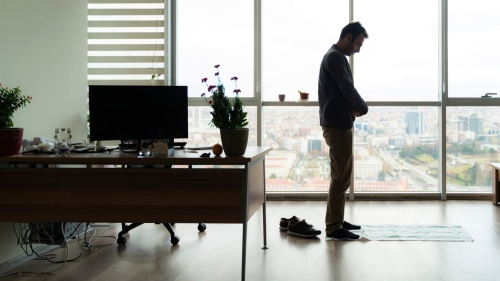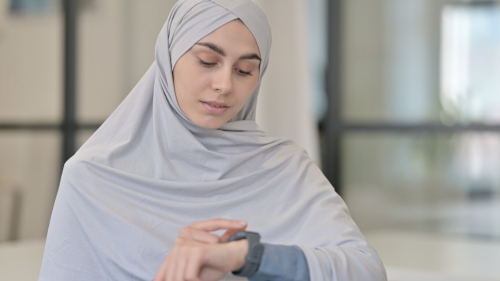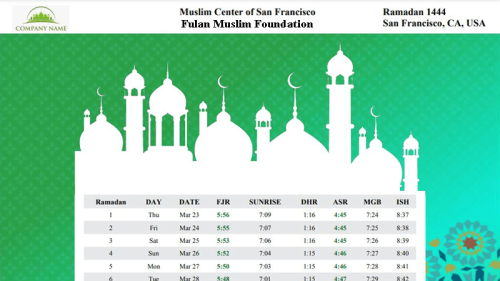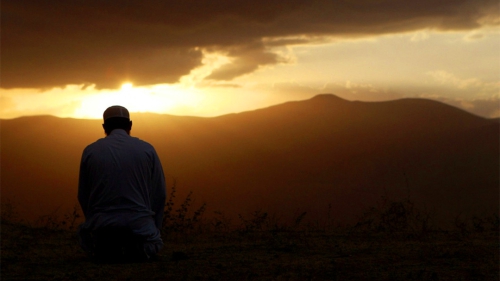Description of Islamic Prayer

Adhan and Salat (Prayers)
Global Prayer Times Calculator
Find a Mosque Near You
Introduction
Prayer times do not remain constant as they are determined by looking at the sun. Consequently the time of a particular prayer would be different in different parts of the World. The Prayer Time Tables are easily available at the mosques and Islamic Centers throughout the World.
Now-a-days electronic devices like "TBilal" or "Spectronic" are available in the market which can tell the prayer times of nearly 1000 major cities of the World. Additionally, iPhones, iPads, Androids, and other devices and provide prayer times using apps like the IslamiCity Prayer Companion. These tools are particularly helpful to the Muslims travelling to non-Muslim countries however, the following general timetable for prayers may be observed in almost any part of the world.
There are five obligatory prayers which are performed at five different times of the day.
|
Of the 5 obligatory prayers mentioned above, one of them contains two raka's, three contain four raka's and one containing three raka's Each kind has been explained separately. All the prayers (to be recited in Arabic) and the postures in which to recite each prayer have been explained with the help of the given figures. The figures have been drawn in the order in which each posture is assumed and the particular prayer recited. In order to memorize the prayer for each posture the reader only needs to look at the number of the figure and listen to the tape while looking at the transcript which gives the Arabic prayer in Roman letters.
Before offering the prayer one must be in good shape and pure condition. It is necessary to wash the parts of the body which are generally exposed to dirt or dust or smog. This performance is called ABLUTION (Wudu') and is preferably carried out as follows:

|
At this stage the ablution is completed, and the person who has performed it is ready to start to start his prayer.When the ablution is valid a person may keep it as long as he can, and may use it for as many prayers as he wishes. But it is preferable to renew it as often as possible. It is also preferable to do it in the said order, although it will be accepted from those who fail to keep this order. Ablution in the said way is sufficient for prayer unless it is nullified for any reason.
Nullification of the Ablution
The ablution becomes nullified by any of the following
|
After the occurrence of any of these things the ablution must be renewed for prayer. Also, after natural discharges, water should be applied because the use of toilet tissues may not be sufficient for the purpose of purity and worship.
The Complete Ablution (Ghusl/Bath)
The whole body with the nostrils, mouth and head must be washed by a complete bath before commencing prayer in any of the following cases:
|
It should be pointed out that at the start of the bath or ablution the intention must be clear that it is for the purpose of purity and worship. Also, a person who is performing an ablution, partial or complete, should combine his performance with some utterances glorifying God and asking Him for true guidance. The forms of such utterances are described in detail in the elaborate sources of the religion. One, however, can say one's own best utterances if one does not know the exact wording. That is sufficient as long as it is in the praise of God and is said with sincerity.
All prayers have been translated from Arabic so that the meaning is understood. But each prayer must be completed in Arabic.
Salat Al-Fajr ![]() | Salat Al-Zuhr
| Salat Al-Zuhr ![]() | Salat Al-Asr
| Salat Al-Asr ![]() | Salat Al-Maghrib
| Salat Al-Maghrib ![]() | Salat Al-Isha
| Salat Al-Isha ![]()
Click on the picture below to watch the video
Salat: How to Perform Daily Prayers ![]()
(I) Allah is Great.
(A) Praise and glory be to you O Allah. Blessed be Your Name, exalted be Your Majesty and Glory. There is no God but You.
(B) I seek Allah's shelter from Satan, the condemned.
(C) In the Name of Allah, the Beneficent, the Merciful.
(D) Praise be to Allah, The Cherisher and Sustainer of the Worlds;
Most Gracious, Most Merciful; Master of the Day of Judgment
Thee do we worship, and Thine aid we seek,
Show us the straight way,
the way of those on whom Thou hast bestowed Thy Grace,
Those whose (portion) is not wrath,
And who go not astray.
(E) "Glorified is my Lord, the Great".
(F) Allah Listens to him who praises Him"
(G) "Our Lord, praise be for you only".
(H) "Glorified is my Lord, the Exalted"
(I) O my Lord forgive me and have Mercy on me"
(J) "All our oral, physical and monetary ways of worship are only for Allah. Peace, mercy and blessing of Allah be on you, O Prophet. May peace be upon us and on the devout slaves of Allah. I testify that there is no God but Allah and I testify that Muhammad is His slave and messenger".
(K) "O God send your mercy on Muhammad and his posterity as you sent Your mercy on Abraham and his posterity. You are the Most Praised, The Most Glorious".
(K) "O God, send your Blessings on Muhammad and his posterity as you have blessed Abraham and his posterity. You are the Most praised, The Most Glorious".
(L) "Our Lord, grant us the good of this world and that of the Hereafter and save us from the torture of hell.
(M) Peace and mercy of Allah be on you".
How to Pray Two Raka's
Position 1: this posture is called Qiyam and it is assumed after having made the intention to pray. Raising both hands upto the ears (palms facing the Qiblah) "Allah-o-Akbar" (1) is said and then holding the left hand with the right hand on top. This position is assumed as shown in position 1. In this position the following prayers are recited:
| (A) Thana (B) Ta'awaz (C) Tasmia (D) Al-Fatiha, and any short sura or a few verses from the Holy Quran. |
Position 2: Saying Allah-o-Akbar this position is assumed as shown in the position. This position is called 'Ruku' and the prayers as given under (E) are recited.
Position 3: While going back to "Qiyam" position the prayer as given under (F) is said. Then having taken this position prayer (G) is said.
Position 4: This position is called 'Sajda'. Saying Allah-o-Akbar one prostrates as shown and then prayer (H) is said.
Position 5: Saying Allah-o-Akbar and rising from the 'Sajda' position this posture is assumed and prayer (I) is said.
Position 6: Saying Allah~~Akbar the Sajda position is resumed and prayer (H) is recited.
This completes one 'Raka'.
Position 7: Saying Allah-o-Akbar this position of 'Qiyam' is assumed once again to begin the second Raka, and the following prayers are recited:
|
Position 8: In this posture these prayers are to be recited
| (J) called "Tashahud" (K) Salat Alan-nabi (L) A short prayer |
Position 9: Having said the above mentioned prayers, turning the face to the right. This prayer is recited as given under (M).
position 10: Then turning the face to the left prayer (M) is said again.
This completes a two-raka' prayer.
In order to perform a THREE RAKA' PRAYER. All the postures and the prayers are the same up to position 8. But this time in this posture only prayer (J) will be recited and then the Qiyam position (position 1) will be resumed to begin the third raka'. This time only Al Fatiha (prayer D) alone will be recited without adding any sura of the Holy Quran. Then all prayers and postures are the same as shown from position 2 to 6 and then 8 to 10..
In order to perform a FOUR RAKA' PRAYER
Positions 1-6 complete the first raka' then positions 7,1 through 6, and 8 complete the second raka'. In position 8 only prayer (J) will be recited and the Qiyam position 1 will be resumed. In position 1 only prayer (D) will be recited without adding any sura. Up to Figure 6 all the prayers are the same as in the first raka'. In Figure 8 only prayer (D) will be recited. Then from position 2-6 all prayers are the same as given for each posture. In position 8 prayer (J), (K), (L) will be recited. Then positions 9-10 are to end the prayer.


















